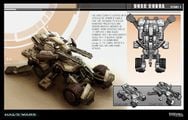Railgun (fiction)
From Halopedia, the Halo wiki
| There is more information available on this subject at Railgun (fiction) on the English Wikipedia. |
A railgun, alternatively spelled rail gun, is a type of electromagnetic projectile weapon. While often confused with Magnetic Accelerator Cannons, rather than accelerating their projectiles through the use of magnetic coils, railguns, as their name suggests, utilize magnetic rails to perform this task. More precisely, a railgun accelerates a conductive projectile along a pair of metal rails, using two sliding or rolling contacts that permit a large electric current to pass through the projectile. This current interacts with the strong magnetic fields generated by the rails and this accelerates the projectile.
Humanity's first tests with railguns took place in the early 21st century. While coilguns are more common in use during the 26th century in form of MACs and many smaller weapon systems, the UNSC is known to utilize railgun technology to some degree. Known railgun-based weapons employed by the UNSC include the M66 light rail gun and M98 light rail guns mounted on SP42 Main Battle Tank and the handheld ARC-920 railgun carbine.[1]
Known railguns
M66 LRG
- Main article: M66 light railgun
The M66 30mm light railgun serves as the primary armament of the SP42 Cobra anti-vehicle/anti-fortification system, and is also used as an anti-vehicle weapon on automated defense turrets.
M98 LRG
- Main article: M98 light railgun
The M98 105mm light railgun serves as the secondary armament of the SP42 Cobra.
Asymmetric Recoilless Carbine-920
- Main article: ARC-920
The ARC-920 is a man-portable weapon system that uses rail accelerator technology to deliver a high-explosive projectile at an incredible speed.[1]
Trivia
In a piece of Halo 3 concept art by Isaac Hannaford, the point defense guns on UNSC frigates are identified as "rail gun turrets". It is unknown if this is how the weapons canonically operate or simply the artist's interpretation.[2]
Gallery
List of appearances
- Halo Wars (First appearance)
- Halo 4
- Halo: Spartan Assault
- Halo: Escalation
- Halo: Mortal Dictata (Mentioned only)
- Halo 5: Guardians
- Halo Wars 2


